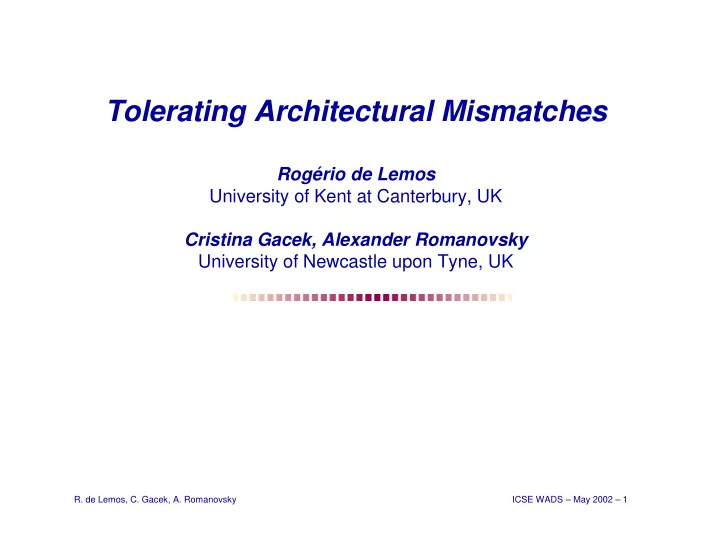

Tolerating Architectural Mismatches Rogério de Lemos University of Kent at Canterbury, UK Cristina Gacek, Alexander Romanovsky University of Newcastle upon Tyne, UK R. de Lemos, C. Gacek, A. Romanovsky ICSE WADS – May 2002 – 1
Motivation System built from existing components (complex glue-code). Software architectures describe the structure of systems: components, connectors and configurations. Architectural mismatches: assumptions on the services provided and required do not match. Analysis and removal. But impossible to localise and correct all architectural mismatches statically. R. de Lemos, C. Gacek, A. Romanovsky ICSE WADS – May 2002 – 2
Motivation Dependability is a system property. Faults can cause errors. Errors can cause failures. Fault tolerance a means to achieve dependability: � provision of service in spite of faults; � error detection, error recovery and fault treatment. Architectural mismatches are “design faults” at the level of integrated systems. R. de Lemos, C. Gacek, A. Romanovsky ICSE WADS – May 2002 – 3
Architectural Mismatches Errors caused by architectural mismatches (ECMs): � latent or detected; � can cause system failure when ECMs affect the system service. D etected D etected EC M s EC M s Errors Errors R. de Lemos, C. Gacek, A. Romanovsky ICSE WADS – May 2002 – 4
Mismatch Tolerance Mismatch prevention, removal, tolerance. In tolerating mismatches there are two abstraction levels: � architectural level where the mismatches are introduced; � execution level where the ECMs are detected and recovered from. Redundancy (e.g. additional information, time) is needed to detect an ECM, to associate an ECM with a mismatch (cf fault diagnosis) and to tolerate it. R. de Lemos, C. Gacek, A. Romanovsky ICSE WADS – May 2002 – 5
Examples Integration of two complex large-grain (COTS) components: C1 and C2. Backtracking-related architectural mismatch: C1 backtracks but C2 does not. Detection of ECM: need additional information (observer, reflection, additional channel, etc.). It can be at the style level. Recover from the ECM: depending on the direction of information two types of buffering can be employed, or an application-level recovery can be used. R. de Lemos, C. Gacek, A. Romanovsky ICSE WADS – May 2002 – 6
Examples Architectural mismatch: call to a non-re-entrant component. In the pipe-filter style filters are non-re-entrant. filterC is unable to deal correctly with data from two sources. filterA filterC filterB R. de Lemos, C. Gacek, A. Romanovsky ICSE WADS – May 2002 – 7
Examples Tolerating this mismatch by extending the style. Detect the ECM: � incoming port of filterC has to be made aware of more than one connector. Recover from the ECM: � queue all the incoming material until the first connection is over. Dealing with one connection at a time. R. de Lemos, C. Gacek, A. Romanovsky ICSE WADS – May 2002 – 8
Future Work � Using an existing ADL for describing architectures and for introducing mismatch tolerance. � Developing typical (re-usable) techniques for tolerating typical mismatches. � Refining existing styles to come up with a set of mismatch tolerance styles (incorporating ECM detection and recovery). � Dealing with mismatch tolerance artefacts through several phases of software development. � Introducing diversity of connectors and components. � Developing architectures that employ general exception handling for mismatch tolerance. R. de Lemos, C. Gacek, A. Romanovsky ICSE WADS – May 2002 – 9
Recommend
More recommend